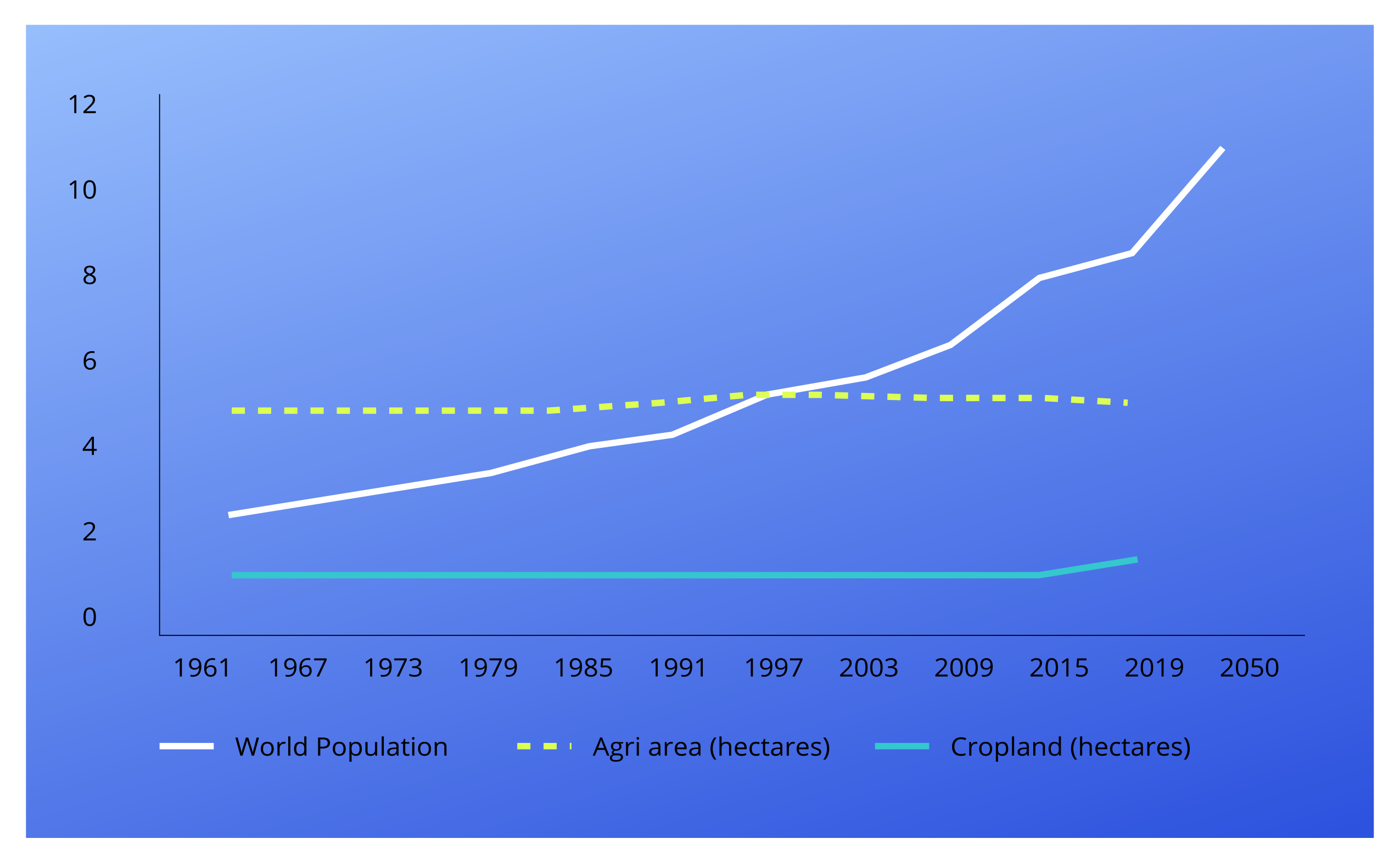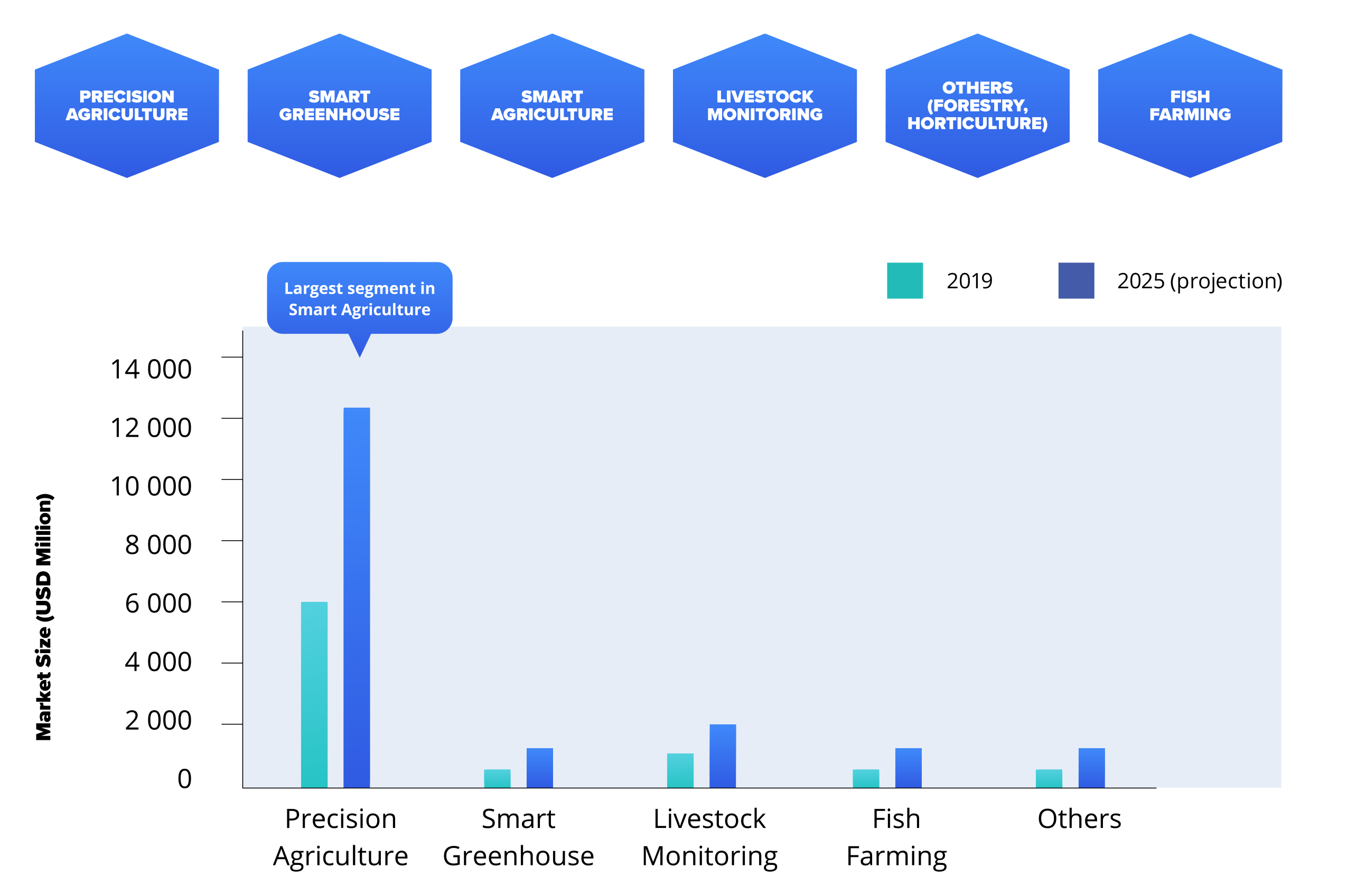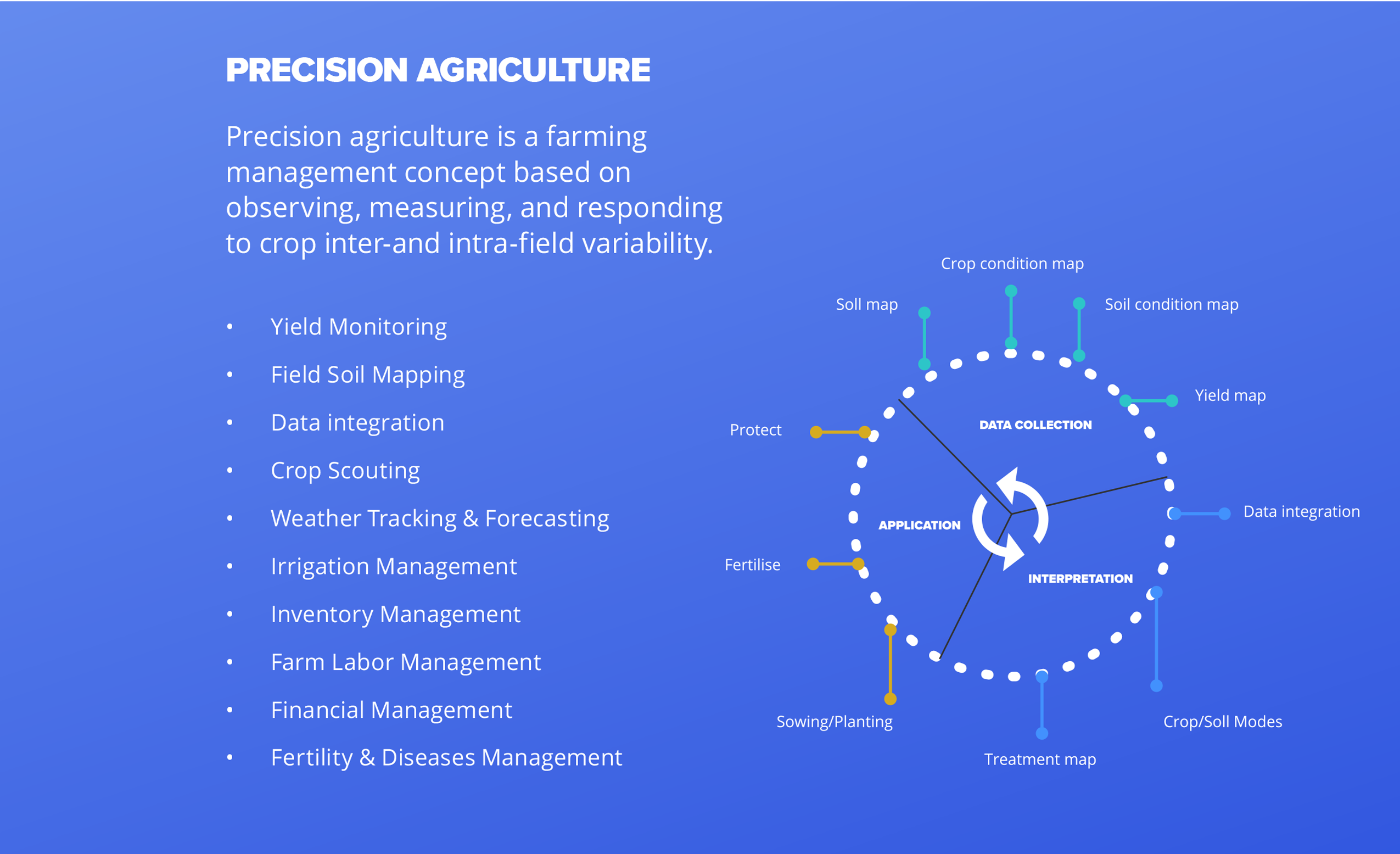AGRICULTURE INDUSTRY CHALLENGES
The agriculture industry has changed significantly over the last forty years. Today it faces several increasingly urgent and complex challenges that will require innovative solutions. Three of the most significant are increasing populations, escalating consumer demand, and resistance to implementing technology.
INCREASING POPULATION
By 2050, the world’s population is predicted to be close to 10 billion. Food production will need to increase to sustain this growth. Yet meeting such demand will be difficult, as worldwide, only about 11% of land is arable, and farming areas are no longer increasing
According to experts, this means that every acre of arable farmland will need to increase crop yields by approximately 70% to satisfy the population growth. To do this, the industry will need to implement disruptive technologies that lead to larger yields, optimized resources, and a significantly increased ROI.
POPULATION VS ARABLE LAND

Figure: By 2050 yields from available farmland need to increase 70%
ESCALATING CONSUMER DEMAND
Another factor contributing to the critical need for AgTech solutions and implementation is the increasing consumer demand for “cleaner” food and transparency along the supply chain.
These demands aren’t just millennials being picky. A growing percentage of shoppers—including 58% in the US alone—insist on organic or clean food.
Whether we’re talking about concerns over pesticides and cancer, allergic reactions, the rise of celiac disease, or fears about contaminated irrigation water leading to disease outbreaks—consumer health increasingly depends on having access to safe, trustworthy food.
Amazon’s acquisition of Whole Foods and Walmart’s entrance to the organics game prove that big business is responding to consumer demand for natural food. In fact, Walmart is now one of the biggest organic grocers in North America.
But with less than 1% of domestic farmland being certified organic, the United States is struggling to meet the demand, leading to Americans spending $1 billion a year to import organic foods.
RESISTANCE TO TECHNOLOGICAL TRANSFORMATION
Compounding these dilemmas is the fact that the agricultural industry is the least-digitized sector worldwide. While Agtech startup investments reached $31 billion in 2020, this influx of support is a very recent development.
Factors such as an aging farmer population, costs, uneven rates of implementation, and a lack of understanding on how best to use the data collected have slowed the adoption of technology. With Agtech expected to generate more than $17 billion by 2026, it’s clear that things are moving in the right direction. But the delay in taking advantage of these tools and technologies means the overall agriculture industry will need to make up for lost time.
AGTECH SOLUTIONS SEEK TO SOLVE INDUSTRY CHALLENGES
There are seven main Agtech solution areas, many of which overlap. Both separately and combined, these solutions incorporate tools and technologies that seek to address this sector’s growing challenges.IoT frequently provides the digitally enabled foundation for other solutions such as robotics, sensors, drones, and GPS.

INTERNET OF THINGS (IOT)
IoT solutions in this sector combine specialized equipment, wireless technology, and software. Its purpose is to help reduce waste, manual labor, and costs while increasing overall yields and productivity. Devices may include several sensors that measure a range of parameters impacting crops, such as the soil’s moisture and temperature or the ground’s electrical conductivity.
All this data allows for real-time monitoring of crop status. It also provides the needed information for statistical modeling. This modeling can be used to predict watering or fertilizing needs or production output, so the appropriate resources are allocated accurately to maximize the yield.
IoT frequently provides the digitally enabled foundation for other robotic, sensor, drone, and GPS solutions.
SENSORS AND ACTUATORS
High-tech sensors measure an array of elements in support of greater overall success. These devices include pH sensors that can pinpoint the presence or absence of nutrients in the soil to optimize a crop’s growth. Temperature sensors can monitor when the soil or air becomes too hot or too cold for that specific crop and alert farmers.
The more accurate the data in farming and agriculture, the better enabled farmers are to respond. Sensors provide the means for some of the most accurate real-time data.
GEO-POSITIONING SYSTEMS (GPS)
Generally, GPS is used to precisely map out farmland and fields. By having a method for efficient geospatial data analysis, farmers can more accurately determine the impact of production methods or notice any alarming crop issues. It also allows for precise seed placement on the best parts of the farmland to increase overall yield. GPS can also help guide other tools such as the Monarch Tractor—a “smart” tractor that is driver-optional—to the correct location.
These highly detailed maps are often combined with other solutions like IoT or machine learning to further assess changes, solve problems, predict outcomes, and provide data.
DRONES AND IMAGE RECOGNITION ANALYTICS
The Agtech sector is slowly incorporating the use of drones and unmanned aircraft, most commonly to capture crop images. These images are later analyzed with software programs that indicate how the crops are evolving. Drones have been used less frequently as remote fertilizing vehicles, but this practice has been on the rise as better GPS tools and sensors become available.
BIG DATA AND MACHINE LEARNING
Like all “smart” solutions, data is required for success. But data alone isn’t valuable if you can’t draw insight from it. Big data and machine learning transform raw information into actionable insights using outcomes from other solutions such as satellite and drone imagery or soil and moisture probes.
IoT devices and sensors also help in the data collection phase. These tools can be placed in tractors, trucks, fields, soil, and plants to aid the collection of real-time data directly from the ground.
After collecting all the data, analysts use other available information—such as weather or pricing models—in the cloud to determine patterns. Analysts can be actual humans or an outgrowth of machine learning algorithms.
The pinpointed patterns and insights can help identify existing issues, like operational inefficiencies and problems with soil quality. They can also formulate predictive algorithms to alert farmers before a problem occurs.
COVID-19 accelerated the use of robotics in agriculture as industry leaders required ways to continue production with less face-to-face interaction. Using technologies and solutions such as sensors, GPS, IoT, and more, has led to the increased use of driverless tractors and other tools.
It’s also spurred innovative efforts like the Autonomous Weeder, which combines robotics, artificial intelligence (AI), and laser technology to navigate fields and identify, target, and eliminate weeds. As this technology only continues to improve, innovations are continually expanding.
For example, the University of North Florida College of Computing, Engineering, and Construction department has teamed up with the University of Central Florida to build multiple autonomous robots. These robots will communicate wirelessly to perform tasks like harvesting crops or applying fertilizer. This project aims to create a prototype of a “multi-robot agricultural information collection system” that can support future Agtech solutions.
PRECISION EQUIPMENT
Advanced farm machinery that allows for precise and streamlined farming, measurements, processes, and more combines many solutions—such as robotics, IoT, drones, sensors, GPS—to perform their work. Machinery such as the Autonomous Weeder or GPS guided tractors mentioned above significantly improve the speed of once lengthy, manual tasks. Sensors in irrigation systems relay feedback on the soil’s needs and allow for precise delivery of the nutrients and moisture for every piece of farmland.
All seven of these solution areas provide the technology and tools to help solve current agricultural challenges and address new ones.
GETTING PRECISE ABOUT THE SMART AG SECTOR
Like the seven main categories of solutions, the terms used to describe this sector also overlap, with Smart Farming, Smart Agriculture, and Precision Agriculture often used interchangeably.
To clarify the differences between the terms, one must look at the focus that guides them.
SMART AGRICULTURE

Figure: By 2025, Precision Agriculture will be the largest segment of Smart Agriculture.
Smart agriculture refers to farms using solutions, technologies, and tools such as sensors, location systems, robots, IoT, and AI.
The goal is to increase the quality and quantity of the crops while optimizing the human labor used. Examples of the tools and technologies used in smart agriculture include:
- Precision irrigation and precise plant nutrition
- Greenhouse climate management and control
- Sensors for the soil, water, light, moisture, and temperature management
- Software, analytics, and optimization platforms
- Location systems using GPS, satellite, and more
- Communication systems based on mobile connection, LoraWan, or others • Robots
Here, the key focus is on using IoT as a mechanism to connect sensors and machines.
This complex system then manages farm functions based on the data it receives. It provides farmers remote monitoring options so they can make strategic decisions and take action via their tablet, phone, or other mobile devices.
SMART FARMING
Smart farming is optimizing complex farming systems by applying information and data technologies. Unlike Precision Agriculture, smart farming focuses on the access to data and the application of this data. In other words, how can the collected information be used smartly and strategically?
PRECISION AGRICULTURE
A segment of Smart Agriculture, precision agriculture is defined by the European Parliament as “a modern farming management concept using digital techniques to monitor and optimize agricultural production processes.”
The key here is the focus on optimization. For example, farmers have previously applied equal amounts of fertilizer across their entire field. A farmer can measure the field’s soil variations using precision agriculture and adapt their fertilizer strategy accordingly. This leads to optimized fertilizer usage, cost savings, and a reduced environmental impact.
PRECISION AGRICULTURE WILL POINT THE WAY
The shift towards precision agriculture and its focus on optimization has become increasingly vital to respond to the market and resource forces.

Global navigation satellite (GNSS)/GPS systems currently represent the largest technology segment of precision agriculture. As the accuracy of these technologies has improved, it’s enabled a large-scale adoption of precision agriculture for geo-positioning and field mapping.
In terms of precision agriculture's earth-bound tools, automation and control systems are mostly preferred as they help minimize labor and electricity costs. Hardware components account for most of the market share, as their consistent evolution has resulted in new devices being introduced with enhanced location and data processing capabilities.
Yield monitoring represents the biggest segment of applications, followed by crop scouting, mapping, soil monitoring, and precision irrigation. Yield monitoring systems measure and record information based on the grain flow, grain moisture, and farm area covered.
This combination of applications, technology, hardware, and systems as part of precision agriculture will help to solve the two biggest challenges of the agriculture industry. First, it addresses the needs of an increasing population utilizing tools such as IoT, sensors, robotics, and more to increase crop yields, decrease waste, and identify areas for expansion.
Next, precision agriculture can respond to escalating consumer transparency demands by implementing systems such as blockchain that ensure clarity throughout the supply chain. It also allows for tracing and identifying potential food safety concerns to address the problem at its source.
THE AGTECH LANDSCAPE AND SOFTSERVE
Agricultural companies can no longer wait to digitize. Digital transformation is required in order to remain competitive. Using solutions, tools, and technologies such as IoT, sensor nodes, drones, field data analysis, and connected farming equipment will help the industry meet increasing global demand. It will also ensure sustainability and minimize negative impacts on the environment.
But these solutions won’t provide those results if they aren’t implemented properly and with a deep understanding of their best performance possibilities. With SoftServe, you’ll have a collaborative partner with over 28 years of extensive experience in big data, AI/ML, image and telemetry data processing, embedded development, and more. Our dedicated global team of experts can empower your team to make the right AgTech choices and implement the best solutions for your unique business needs.
Let’s talk if you’re ready to start your AgTech digital transformation, optimize your current efforts, and remain at the forefront of the latest agricultural industry changes.

